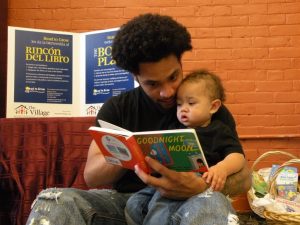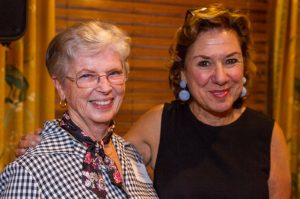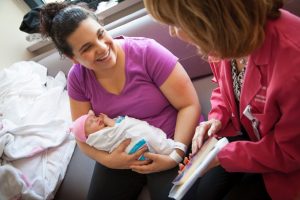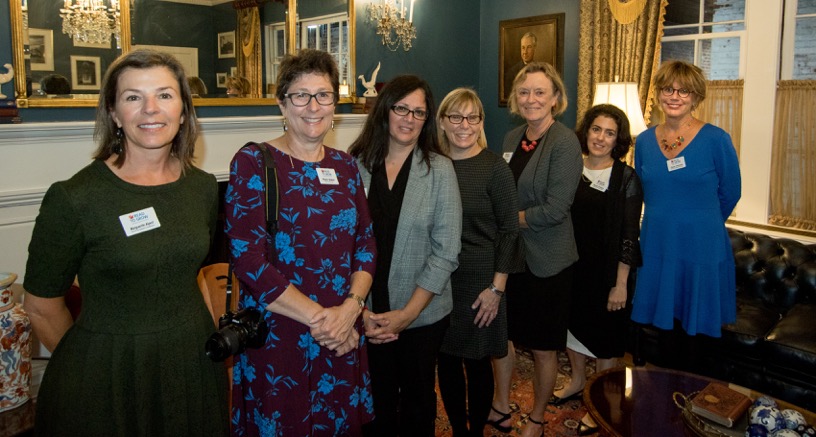Children flourish in all aspects of their lives when language and literacy skills begin at birth with their first and most important teachers – their parents. It’s a simple but important mission that Read to Grow has been making a reality since its inception almost 20 years ago.
The Branford-based nonprofit set out with a tall order: to provide a brand-new book to every child born in every hospital in Connecticut.
Initially, the baby board book, “Welcome to the World!” by local author Nancy Elizabeth Wallace, was distributed in a literacy packet given to every family with a child born at Yale-New Haven Hospital. Today, the flagship Books for Babies program is in an additional 13 hospitals throughout the state, reaching at least 61 percent of babies born in Connecticut every year.

And the nonprofit keeps growing. Through various programs that have been added to its roster, to date, Read to Grow has provided more than 1.8 million children’s books to more than one million people since the year 2000. Remarkably, the continuum of services provided statewide – and the growing number of books distributed – are achieved with just two full-time and seven part-time staff, along with more than 100 dedicated volunteers.
The Books for Kids program – formed several years after Books for Babies started – provides books and literacy education to families, childcare providers, doctors and teachers, along with a variety of other organizations and groups. Over the last four years, Book Places and Partnerships were added to the mix as formal collaborations with other nonprofits to reach more low-income and at-risk families.
Just recently, in October, Read to Grow launched Early Steps to School Success in New Haven elementary schools in partnership with Save the Children, which has been implementing the innovative early learning program for at-risk children in rural communities nationwide for over a decade. New Haven is the only cityscape adaptation of the program.

A Dream Coming True
Roxanne J. Coady, Read to Grow’s founder and board chair, isn’t surprised the organization’s original mission is coming true in so many ways. Instead, she’s grateful.
“Our success is certainly what I’d hoped for,” she says. “I think the notion was a simple story I’ve told a million times. When I learned there was an eight-year-old boy at the Fair Haven Clinic [in New Haven] who had never owned a book, it seemed like a big problem. And so, my goal was to make sure there wasn’t another eight-year-old who didn’t have a book.”
Coady, who since 1989 has owned independent bookstore R.J. Julia Booksellers in Madison, adds: “I really think reading changes lives, which is why I opened a bookstore.”
As Read to Grow expanded its reach, the complexities of the literacy problem became more apparent, she says.
“The research about zero to three [years old] being the most critical time for brain development was coalescing in the late 1990s and is now considered common currency,” Coady says.
Explaining why Read to Grow is so big on giving books, Kyn Tolson, executive director, points to a 20-year worldwide study that was published in 2010. Its author, Mariah Evans from the University of Nevada in Reno, found that the number of books in a home is the top factor predicting success for children. The more books children have in the home, the higher level of education they will attain.
“It’s not the wealth or education level of a family that’s a predictor, it’s that books create home libraries,” Tolson says. By having books in the home, she explains, parents create the expectation for their children that books and reading are important.
Read to Grow’s work extends beyond just literacy, says Coady.
“There’s a disconnect in our culture that what’s going on over here isn’t really impacting me,” she says. “But these problems impact quality of life, what our cities look like, how our government spends its money – a lot of things, economically. But most importantly, it ought to reinforce our need to be compassionate and thoughtful in the macro sense. There’s ‘us’ and ‘them’ and it should be ‘we.’ ”
Read to Grow, she adds, is implementing change in a cost-effective way.
“We have the slightest overhead and the most efficient, hard-working staff and volunteers. So, a large percentage of the dollars go to the families that are impacted,” she notes.
On the Ground
Marguerite Alpert is the Books for Babies coordinator and is expanding a new component of the program – The Prenatal Project, which aims to provide literacy information and baby books to women receiving prenatal care at community health centers and clinics.
“I have a teaching background, and we know as teachers, the more times people hear a message, the more likely it is to stick,” Alpert says. “The Prenatal Project speaks of our overarching goal, which is to help parents understand that they are their children’s first and best teachers and that it’s never too early to start reading.”

Alpert points out that an infant’s auditory senses are fully engaged by 20 weeks’ gestation.
“It’s always really fun to see the expression on people’s faces when they realize they can read to their babies before they’re even born,” she says. “And that babies recognize your voice.”
Linda Sylvester, co-coordinator of Books for Kids, remembers a time 12
years ago, when a Bridgeport mother called to request books for her two- and four-year-old children.
“The little boy loved the books so much, he started sleeping with them under the pillow,” Sylvester recalls. “The kids are now in middle school and high school, and the mom still calls us periodically for books. She knows how important it is. Her kids remember Read to Grow and ask, ‘Can we call that book lady?’ It speaks to the relationships we’ve made.”
Evelyn Tomasello, the bilingual co-coordinator of Books for Kids, addresses the state’s increasing need for books and materials in both English and Spanish.
“Being from Puerto Rico, I can say to Spanish-speaking parents that in our culture, you don’t talk much to little kids, [even though] they’re listening, they’re learning, their brains are developing,” she says. “And the parents listen when I tell them that’s not the way to do things. We’re giving them tools, educating them, helping them. It’s really powerful. That’s what makes us unique. If parents are the first teachers, we have to educate them first.”
Another Read to Grow partnership involves providing an educational component and children’s books to the Connecticut Food Bank’s GROW! [Grocery On Wheels] Truck, which travels to the locations of Head Start and other early childhood programs in Connecticut.
“It’s fantastic,” Tomasello says. “Families have to attend a half-hour literacy workshop before going on the truck to get food. We talk about why it’s so important to read to your kids. It’s a nurturing partnership, providing books and food.”
Read to Grow leaders say the biggest challenge in educating new parents is teaching them how critical it is to delay the onset of screen time.
“The fact is, the American Academy of Pediatrics has said unequivocally that children from birth to 18 months should have zero screen time,” Alpert says. “They recommend that even up to age five, children shouldn’t have more than one hour of any type of screen time [daily]. There is strong evidence now that bright colors and flashing lights are disruptive to the development of the brain.”
Tomasello adds, “I saw a mom with a two-year-old and the baby was holding a device. We explain why that’s bad for the child, but we also praise parents for not being on their phones when they come to our workshops.”
An Exciting Time
“Read to Grow started from something being a negative, terrible situation that Roxanne saw and imagined,” Tolson says. “How can there be an eight-year-old that doesn’t have a book in the U.S. in 2000? But Coady tackled the problem in a positive, passionate way and that trickles down to every single person connected with Read to Grow.”
“I think our success has been making people feel that passion,” Tolson continues. “You can tell them to care, what to think, but, ‘Don’t tell me, show me.’ Our ‘show’ is passion and caring, the fire and energy about what we do that you can see in our staff.”
Robin Baker has been the nonprofit’s office manager for the past 17 years.
“I’ve stayed so long because I see so much value in the mission,” Baker says. “The energy behind it from the key people who were involved was pretty intense from the beginning. They had so much in their hearts, so much energy to keep it going. And the volunteers are amazing.”
She adds, “I’m here when these families call and say, ‘Can I get books?’ The children seem to respond to the books with more joy than they do to any toy or gift. It never changes. It’s fun to be a part of making this happen. It’s meaningful; there is such a need. And it seems like such a simple way to help children.”
For more information about Read to Grow, visit readtogrow.org.







More Stories
Hospital for Special Care’s Ivan Lendl Adaptive Sports Camp
Special Olympics Connecticut: Supporting and Inspiring a Special Community
Healing Meals: Supporting Nourishment During a Health Crisis and Beyond